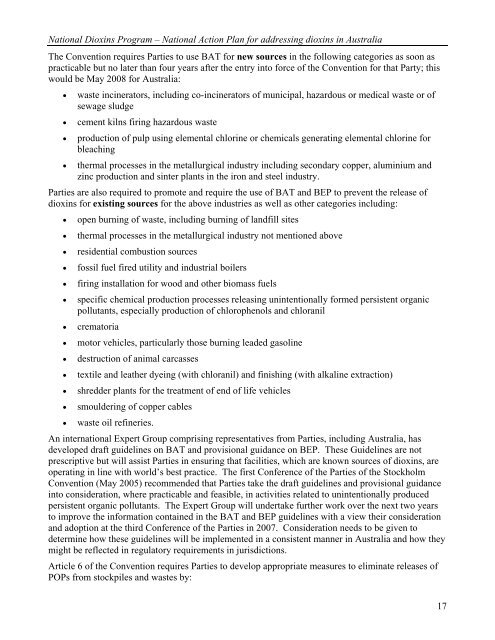National Action Plan for Addressing Dioxins in Australia
National Action Plan for Addressing Dioxins in Australia
National Action Plan for Addressing Dioxins in Australia
- No tags were found...
Create successful ePaper yourself
Turn your PDF publications into a flip-book with our unique Google optimized e-Paper software.
<strong>National</strong> <strong>Diox<strong>in</strong>s</strong> Program – <strong>National</strong> <strong>Action</strong> <strong>Plan</strong> <strong>for</strong> address<strong>in</strong>g diox<strong>in</strong>s <strong>in</strong> <strong>Australia</strong>The Convention requires Parties to use BAT <strong>for</strong> new sources <strong>in</strong> the follow<strong>in</strong>g categories as soon aspracticable but no later than four years after the entry <strong>in</strong>to <strong>for</strong>ce of the Convention <strong>for</strong> that Party; thiswould be May 2008 <strong>for</strong> <strong>Australia</strong>:• waste <strong>in</strong>c<strong>in</strong>erators, <strong>in</strong>clud<strong>in</strong>g co-<strong>in</strong>c<strong>in</strong>erators of municipal, hazardous or medical waste or ofsewage sludge• cement kilns fir<strong>in</strong>g hazardous waste• production of pulp us<strong>in</strong>g elemental chlor<strong>in</strong>e or chemicals generat<strong>in</strong>g elemental chlor<strong>in</strong>e <strong>for</strong>bleach<strong>in</strong>g• thermal processes <strong>in</strong> the metallurgical <strong>in</strong>dustry <strong>in</strong>clud<strong>in</strong>g secondary copper, alum<strong>in</strong>ium andz<strong>in</strong>c production and s<strong>in</strong>ter plants <strong>in</strong> the iron and steel <strong>in</strong>dustry.Parties are also required to promote and require the use of BAT and BEP to prevent the release ofdiox<strong>in</strong>s <strong>for</strong> exist<strong>in</strong>g sources <strong>for</strong> the above <strong>in</strong>dustries as well as other categories <strong>in</strong>clud<strong>in</strong>g:• open burn<strong>in</strong>g of waste, <strong>in</strong>clud<strong>in</strong>g burn<strong>in</strong>g of landfill sites• thermal processes <strong>in</strong> the metallurgical <strong>in</strong>dustry not mentioned above• residential combustion sources• fossil fuel fired utility and <strong>in</strong>dustrial boilers• fir<strong>in</strong>g <strong>in</strong>stallation <strong>for</strong> wood and other biomass fuels• specific chemical production processes releas<strong>in</strong>g un<strong>in</strong>tentionally <strong>for</strong>med persistent organicpollutants, especially production of chlorophenols and chloranil• crematoria• motor vehicles, particularly those burn<strong>in</strong>g leaded gasol<strong>in</strong>e• destruction of animal carcasses• textile and leather dye<strong>in</strong>g (with chloranil) and f<strong>in</strong>ish<strong>in</strong>g (with alkal<strong>in</strong>e extraction)• shredder plants <strong>for</strong> the treatment of end of life vehicles• smoulder<strong>in</strong>g of copper cables• waste oil ref<strong>in</strong>eries.An <strong>in</strong>ternational Expert Group compris<strong>in</strong>g representatives from Parties, <strong>in</strong>clud<strong>in</strong>g <strong>Australia</strong>, hasdeveloped draft guidel<strong>in</strong>es on BAT and provisional guidance on BEP. These Guidel<strong>in</strong>es are notprescriptive but will assist Parties <strong>in</strong> ensur<strong>in</strong>g that facilities, which are known sources of diox<strong>in</strong>s, areoperat<strong>in</strong>g <strong>in</strong> l<strong>in</strong>e with world’s best practice. The first Conference of the Parties of the StockholmConvention (May 2005) recommended that Parties take the draft guidel<strong>in</strong>es and provisional guidance<strong>in</strong>to consideration, where practicable and feasible, <strong>in</strong> activities related to un<strong>in</strong>tentionally producedpersistent organic pollutants. The Expert Group will undertake further work over the next two yearsto improve the <strong>in</strong><strong>for</strong>mation conta<strong>in</strong>ed <strong>in</strong> the BAT and BEP guidel<strong>in</strong>es with a view their considerationand adoption at the third Conference of the Parties <strong>in</strong> 2007. Consideration needs to be given todeterm<strong>in</strong>e how these guidel<strong>in</strong>es will be implemented <strong>in</strong> a consistent manner <strong>in</strong> <strong>Australia</strong> and how theymight be reflected <strong>in</strong> regulatory requirements <strong>in</strong> jurisdictions.Article 6 of the Convention requires Parties to develop appropriate measures to elim<strong>in</strong>ate releases ofPOPs from stockpiles and wastes by:17
















